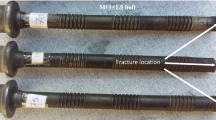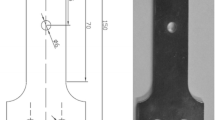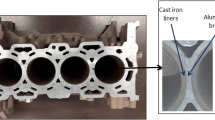Abstract
Inconel 718 is a structural material used to produce highly stressed rotating aero-engine components. Such components have to meet the most exacting requirements in terms of reliability and component service life. Bolt holes in rotating turbine and compressor discs are among the most highly stressed geometric features of jet engines. In-flight failure of these bolt holes may, in fact, result in the loss of the aircraft and imperilment of human lives. For this reason, the quality and reliability of hole-making are of utmost importance. The integrity and reliability of the machined engine component are the sole factors for which all efforts are taken for system of design, material selection, manufacturing and inspection of these rotating aero-engine components. This paper aims to contribute towards a safer production of bolt holes in highly stressed turbine discs made from nickel based super-alloy, which acts as a linking sequence between microstructural surface integrity and descriptive residual stress parameters. The magnitude of the residual stress was determined by means of combining two various methods, namely surface stress measurement by X-ray diffraction and hole-drilling, to achieve residual stress in the profile depth.
Similar content being viewed by others
References
Madariaga A, Esnaola JA, Fernandez E, Arrazola PJ, Garay A, Morel F (2014) Analysis of residual stress and work-hardened profiles on Inconel 718 when face turning with large-nose radius tools. I nt J Adv Manuf Technol 71:1587–1598
Herbert CRJ, Kwong J, Kong MC, Axinte DA, Hardy MC, Withers PJ (2012) An evaluation of the evolution of workpiece surface integrity in hole making operations for a nickel-based superalloy. J Mater Process Technol 212:1723–1730
Renand X, Liu Z (2016) Influence of cutting parameters on work hardening behavior of surface layer during turning superalloy Inconel 718. Int J Adv Manuf Technol 86:2319–2327
Oliveira GP, Fonseca MC, Araujo AC (2017) Analysis of residual stress and cutting force in end milling of Inconel 718 using conventional flood cooling and minimum quantity lubrication. Int J Adv Manuf Technol 92:3265–3272
Chamanfara A, Monajatia H, Rosenbauma A, Jahazia M, Bonadarb A, Morinb E (2017) Microstructure and mechanical properties of surface and subsurface layers in broached and shot-peened Inconel-718 gas turbine disc fir-trees. Mater Charact 132:53–68
Chen YC, Liao YS (2003) Study on wear mechanisms in drilling of Inconel 718 superalloy, Dept. of Mechanical Engineering. National Taiwan University, Taipei
Ezugwu EO, Wang ZM, Okeke CI (1999) Tool life and surface integrity when machining Inconel 718 with PVD and CVD coated tools. Tribol Trans 42(2):353–360
Eckstein M, Mankova I (2012) Monitoring of drilling process for highly stressed aeroengine components. 5th CIRP Conference on High Performance Cutting, Procedia CIRP 1:587–592
Sharman ARC, Amarasinghe A, Ridgway K (2008) Tool life and surface integrity aspects when drilling and hole making in Inconel 718. J Mater Process Technol 200:424–432
Eckstein M (2004) Process Monitoring-ein innovativer Ansatz zur Steigerung der Zuverlässigkeit höchstbelasteter Bauteile der Fluggasturbine, Deutscher Luft- u. Raumfahrtkongress, Jahrbuch 2004
Champoux RL, Underwood JH, Kapp JA (1988) Analytical and experimental methods for residual stress effects in fatigue, ASTM, Philadelphia
Ehlers M, Müller H, Lohe D (1997) Simulation of stresses and residual stresses due to immersion cooling of tempering steel, ICRS-5, Linkoping/Sweden, p 400–405
Yu HJ, Schröder P, Besserdich A (1996) Zur Modellierung und Simulation der Wärmebehandlung metallischer Werkstoffe, HTM 51:48–51
Kleiner M, Kopp R, Homberg W (2004) Analysis of residual stresses in high pressure metal forming. Ann CIRP 53:211–214
Adam P (1998) Fertigungsverfahren von Turboflugtriebwerken. Birkhäuser Verlag, Basel
Adam P, Eckstein M (1992) Zeitfestigkeit und Randschicht-Eigenschaften durch Zerspanung bei Nickellegierungen, Materialwissenschaft. u. Werkstofftechnik 27:272–279
Liu CR (2002) A novel single-step superfinish hole-making process for maximum fatigue life. Research project abstract
Eckstein M (2007) Untersuchungen zur Intagritat gehonter Bolzenbohrungen in hochbelasteten Bauelementen der Fluggasturbine. In: Hoffmeister HW, Denkena B (ed) Jahrbuch Schleifen, Honen, Lappen und Polieren, Vulkan-Verlag GmbH, Essen, pp 319–328
Wessels T (2007) Bohren in Titan- und Nickelbasislegierungen, Dissertation. TU Braunschweig, Schriftenreihe des IWF, Vulkan Verlag
Farid AA, Sharif S, Nazami H (2009) Effect of machining parameters and cutting edge geometry on surface integrity when drilling and hole making in Inconel 718. SAE Int. J Mater Manuf 2:564–569
Osterle W, Li PX, Nolze G (1999) Influence of surface finishing on residual stress depth profiles of a coarse-grained nickel-based superalloy. Mater Sci Eng A 262:308–311
Kwong J, Axinte DA, Withers PJ (2009) The sensitivity of Ni-based superalloy to hole making operations: influence of process parameters on subsurface damage and residual stress. J Mater Process Technol 209:3968–3977
Ucak N, Cicek A (2018) The effect of cutting conditions on cutting temperature and hole quality in drilling of Inconel 718 using solid carbide drills. J Manuf Process 31:662–673
Beer N, Ozkaya E, Biermann D (2014) Drilling of Inconel 718 with geometry-modified twist drills. Procedia CIRP 24:49–55
Herbert CRJ, Axinte DA, Hardy MC, Brown PD (2011) Investigation into the characteristics of white layers produced in a nickel-based superalloy from drilling operations. Procedia Eng 19:138–141
Dutilh V, Dessein G, Alexis J, Perrin G (2010) Links between machining parameters and surface integrity in drilling Ni-superalloys. Adv Mater Res 112:171–178
NN (2007) Metallography principles and procedures. LECO Corporation, St. Joseph
Schatt W, Worch H (1996) Werkstoffwissenschaft. 8th edn. Wiley-VCH, Weinheim
Sharman ARC, Hughes JI, Ridgway K (2004) Workpiece surface integrity and tool life issues when turning Inconel 718™ nickel based superalloy. Mach Sci Technol Int J 8(3):399–414
Axinte DA, Andrews P (2006) Some considerations on tool wear and workpiece surface quality of holes finished by reaming or milling in a nickel base superalloy. Proc Inst Mech Eng B J Eng Manuf 221:591–603
Sharman ARC, Hughes JI, Ridgway K (2015) The effect of tool nose radius on surface integrity and residual stresses when turning Inconel 718 TM. J Mater Process Technol 216:123–132
Sharman ARC, Hughes JI, Ridgway K (2006) An analysis of the residual stresses generated in Inconel 718TM when turning. J Mater Process Technol 173:359–367
Hood R, Soo SL, Aspinwall DK, Andrews P, Sage C (2011) Twist drilling of Haynes 282 superalloy, 1st CIRP Conference on Surface Integrity. Procedia Eng 19:150–155
Acknowledgements
This work was supported by the projects VEGA 1/0219/18: Development of intelligent monitoring system for zero-defect production of irreplaceable parts and VEGA 1/0434/15: Research on process dependent interface when milling with small diameter of end mill cutters. The authors wish to thank the Faculty of Mechanical Engineering of TU in Košice for the materials and financial support within the project development of the intelligent monitoring system for zero defect production. Finally, the authors would like to express their gratitude to Josef Beňo, PhD for his valuable comments and suggestions to improve the quality of this manuscript.
Author information
Authors and Affiliations
Corresponding author
Rights and permissions
About this article
Cite this article
Vrabeľ, M., Eckstein, M. & Maňková, I. Analysis of the metallography parameters and residual stress induced when producing bolt holes in Inconel 718 alloy. Int J Adv Manuf Technol 96, 4353–4366 (2018). https://doi.org/10.1007/s00170-018-1902-4
Received:
Accepted:
Published:
Issue Date:
DOI: https://doi.org/10.1007/s00170-018-1902-4




